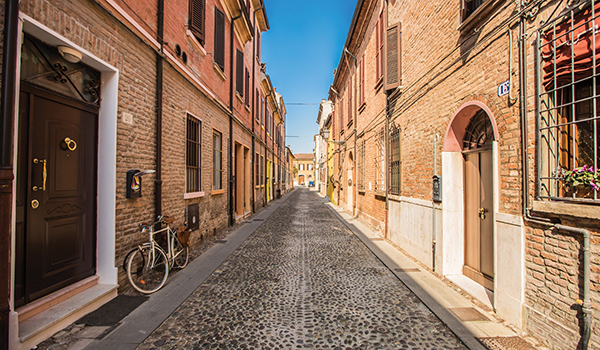Ferrara was Europe’s first modern city, and plans laid here have been copied across the continent. Sara Scarpa visits the often overlooked city of the Este family…
One evening earlier this year, I watched a television programme about the Signorie, the governing bodies of old Italy, and was fascinated by the stories of these famous families who ruled il Bel Paese during the Medieval and Renaissance periods.
What really caught my attention was the tale of the younger branch of the Este House, who ruled Ferrara for over three centuries. I must confess that I did not know much about them before, but I was inspired to read more. The history of the Estensi is deeply connected to the history of Ferrara.
The 15th and 16th centuries were the golden age for the Estensi, and for Ferrara as well. During this time the city became one of Italy’s greatest centres of Renaissance culture; it hosted a famous university, great writers such as Boiardo, Ariosto and Tasso, and artists such as Tura, Garofalo and Dosso. To better understand the story of Ferrara, and of the Estensi, I knew I really needed to see the city for myself.
Inspired by the stories of the past splendour of the Este court I tried to picture what Ferrara would have looked like during its golden age, when the signorie occupied the delizie (the stunning family residences) in the city and in the surrounding countryside. In these delizie (literally, “delights”) – which they would have reached by boat along the many no longer existing canals – the ruling families would have spent much of their time in leisure – relaxing, eating, hunting and partying.
Fascinated by the description of the ‘City of the Renaissance’, I decided to plan the trip. I had, of course, to convince Iain to come along and photograph the city. The fact that he was still recalling the exquisite dishes of our last trip to Emilia-Romagna meant this was an easy sell – just the mention of the cappellacci, the pasticcio di maccheroni alla ferrarese (macaroni pie) and Fortana wine was good enough for him to consent.
Embarking a train departing from Venice we reached our destination with a pleasant journey of just over an hour, passing via Padua. Alighting from the train our first surprise was waiting: only a handful of people joined us in getting off in Ferrara, and none of them appeared to be tourists.
The walk to the centro storico is a simple one – after fifteen minutes through Viale Cavour, a nice residential street with elegant Liberty palaces, we arrived in the heart of the city and found ourselves at the foot of the imposing castle, the Castello Estense.
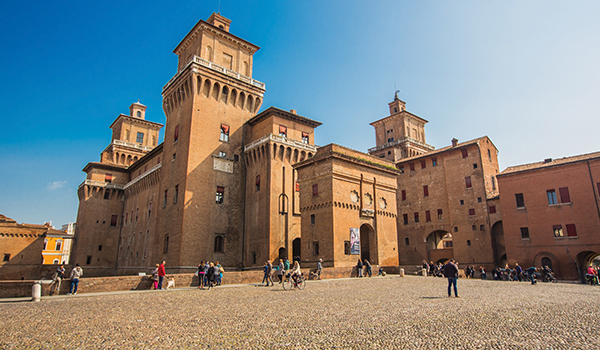
This was initially built as a fortress in 1385 to defend the Este family after a dangerous revolt had risen against them. Constructed according to the project of Bartolino da Novara, it was continuously renovated at least until the 16th century. The dukes who ruled Ferrara embellished it with the addition of roof terraces, marble balconies, a Renaissance-style courtyard, frescoes and elegant apartments. Today, it has lost its austerity and looks more like a beautiful residence witnessing the great past of the Este court.
Symbol of power
The castle is the symbol of the power of the family, and of Ferrara itself. It is also the first stop to get to know the city. On the ground floor you will find the tourist information centre, where you can gather all the advice you need about exhibitions and museums. The staff working there – and the Ferraresi in general – are very friendly and sociable people. Perhaps it is because they are not used to having many tourists around but they are always extremely helpful and kind. In the small shop inside the castle we met an elderly local woman, Lara, who chatted to us. She talked first a little bit about the history of the castle, then for quite a while about her life in Ferrara, where she has been living since she was born, and finally, about her favourite ferraresi food.
A proper visit to the castle is definitely worth it. Still complete with moat and drawbridge, when you step in you will feel like if you are stepping back in time. You can visit the old kitchens, the dungeons where the most infamous criminals were kept and the rooms where the Este family used to live. From the top of the Torre dei Leoni you can also enjoy a great view of the city.
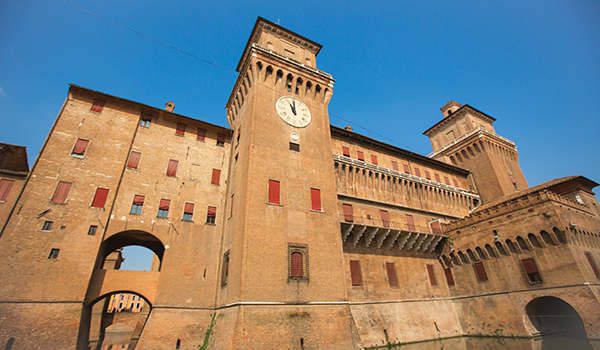
It is in this castle that in 1425, Niccolò III, condottiere and Marquis of Ferrara, had his second wife, Parisina Malatesta, and her lover (his own illegitimate son, Ugo d’Este) murdered for an alleged affair. The fact might sound quite unfair, especially when you know that Niccolò himself boasted of sleeping with hundreds of mistresses – even the chroniclers of the time said that he had children everywhere on both sides of the river Po!
During our visit there was also a wonderful market flanking two sides of the castle, with stalls of local artisans selling jewellery and small handmade objects. Looking over the square stands the brooding statue of Girolamo Savonarola, who seems definitely intent on some more serious business than the browsers in the piazza. The Dominican friar and preacher, born in Ferrara and active in Renaissance Florence, stands imposingly in the middle of the square – which takes its name from him – his arms showing the same energetic passion that five hundred years ago caused him to be burnt at the stake.
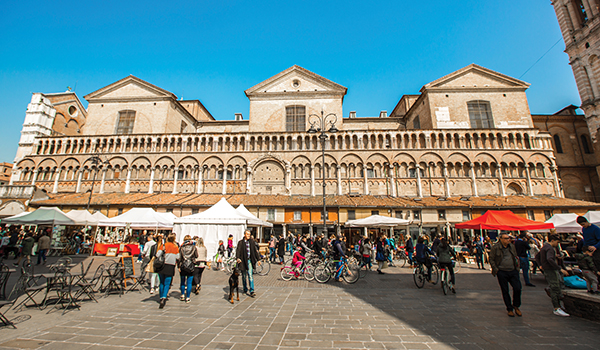
Nearby, on top of the Arco del Volto del Cavallo, the arched entrance to the Palazzo Municipale, you will notice two other bronze statues. On the right, if you are facing the palace, stands the equestrian statue of Niccolò III d’Este (whom we have just mentioned for his fame with women), and next to him, on the left, seated on his throne in the process of administrating justice, one of his illegitimate sons, Borso d’Este, Duke of Ferrara and first Duke of Modena. Father and son stand directly in front of the cathedral and seem almost to be putting the Este House stamp of approval on it, as they have done on everything else in the city.
Architectural image
The Cattedrale di San Giorgio, dedicated to the patron saint of the city, is a complete mix of styles from different periods and is therefore an architectural image of the history of Ferrara. The side of the cathedral facing Piazza Trento e Trieste presents two galleries of small columns of different shapes and, at ground level, the Loggia dei Mercanti, which has housed shops since medieval times.
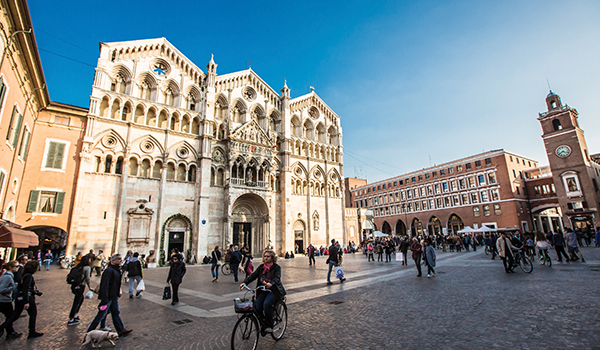
Another market filled the piazza when we visited, the Antiques and Craft Market. It takes place on the first Saturday and Sunday of every month (except August) offering antiques and objects to collect, furniture, ceramics, coins, books, prints, etc. I love antiques and I was so tempted by all those wonderful pieces of furniture that I wanted to buy them all! Luckily I managed to resist and, to keep myself happy, I bought an old book about the city of Ferrara instead.
We had to leave as it was getting late and we were ready for some pumpkin cappellacci – the signature primo piatto in Ferrara, which was recommended in my guide and is amongst Lara’s favourites as well. They are a sort of ravioli stuffed with a filling of pumpkin, Parmigiano Reggiano and nutmeg, and served with butter and sage.
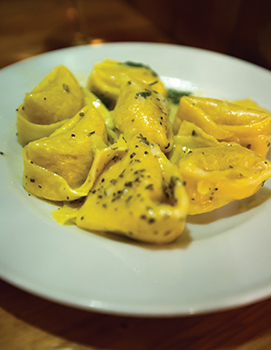
We decided to stop for lunch Al Brindisi, the oldest tavern in the world, as certified by Guinness. Titian, Tasso, Ariosto and Copernicus all drank and ate here. The astronomer lived in the little rooms just above the osteria while he was studying in Ferrara and it was there that he started elaborating his revolutionary astronomical theory.
Selection of wines
At this tavern you are spoilt for choice with an amazing selection of wines and extremely knowledgeable staff who are more than happy to walk you through the selections. Settling on a bottle of Rosso di Fred, one of the unique wines created by the owner of the osteria, we sampled local cured meats and a large serving of cappellacci di zucca.
Now fully recharged, we took a stroll along the quiet cobbled streets of the medieval area, passing the ancient Jewish ghetto and the picturesque Via delle Volte. Continuing along Via Mazzini and Via Saracena, where the River Po once flowed, we reached our destination, the Palazzo Schifanoia (one of the few delizie still surviving) and paid a visit to admire the stunning 15th-century frescoes of the Salone dei Mesi. The frescoes are a must and, still in their original setting after centuries, they provide a wonderful spectacle.
The palace has also a fairly extensive garden to relax in. After a short rest lying on the grass, we started walking back north in the direction of the Herculean Addition. We passed Corso Giovecca, which separates the medieval part of the city from its Renaissance addition. Before some more walking, we obviously had to make a stop at the patisserie Caffè del Corso to try some Ferrara specialities, especially as I could not wait to try the Tenerina cake I had read so much about. It definitely did not fail expectations – it is just the perfect cake, crunchy on the outside but soft (tenera) and moist inside.
Walking along the magnificent Corso Ercole I d’Este, we got to the most spectacular crossroad I had ever seen, the Quadrivio degli Angeli. This is the point where three stunning Renaissance palaces meet: Palazzo dei Diamanti, Palazzo Turchi di Bagno and Palazzo Prosperi-Sacrati.
The first modern city
The crossroad is the focal point of the Renaissance addition and the centre of the first modern city in Europe. Ferrara is indeed a great example of town planning; it has greatly influenced the progress of town planning in general in Italy over the centuries. In 1492, while Columbus was discovering the New World, the architect Biagio Rossetti was busy expanding Ferrara according to a completely new urban design concept.
Since 1995 UNESCO has included the historic centre of Ferrara in the list of World Cultural Heritage as a “wonderful example of a town planned in the Renaissance and still keeping its historic centre intact”. In 1999 the UNESCO World Heritage status was extended to the nearby territory of the historic Po Delta and to the delizie in the natural landscape of the area.
Surprisingly, despite its UNESCO World Heritage status and its proximity to Bologna, Ferrara is still overlooked. This hidden gem is often forgotten when people visit Emilia-Romagna and it should definitely be added to the itinerary in this region. Add it to your bucket list if you have not done so yet as it is a history-rich place, packed with things to see – and to do so you will need at least a weekend to enjoy it fully.
You can spend an afternoon cycling along the medieval walls whilst enjoying the quiet, tree-lined paths or, walk along the wide and elegant Renaissance roads and then take a rest in its beautiful gardens and piazze (such as Parco Massari and Piazza Ariostea). Admire the art at the many galleries and museums and, last but not least, savour the local gastronomical specialities – without forgetting to try the Tenerina cake, of course!
